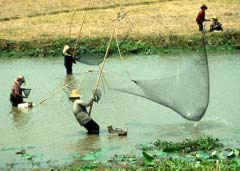Rice-fish systems
What is a rice-fish system?
 Rice-fish system in Central Thailand.
Rice-fish system in Central Thailand.A rice-fish system is an integrated rice field or rice field/pond complex, where fish are grown concurrently or alternately with rice. Fish may be deliberately stocked (fish culture), or may enter fields naturally from surrounding water ways when flooding occurs (rice field fisheries), or a bit of both. Fish yields can range widely from of 1.5 to 174 kg/ha/season depending on the type of rice fish system, the species present, and the management employed.
Why have rice-fish system?
Rice-fish systems allow the production of fish and other aquatic animals, from the same rice field area and generally without causing reductions in rice yields. This source of animal protein may be important for household nutrition and farm income.
What species of fish are found in rice-fish systems?
The most common indigenous fishes [common name (Genus)] found in Asian rice fields are the following:
- White fish (small plant or plankton eating species) such as Danios (Rasbora), Barbs (Puntius), Snakeskin Gourami (Trichogaster), and Half beaks (Xenentodon).
- Black fish (often carnivorous air breathers that can survive low or no oxygen levels) such as Snakehead (Channa), Catfish (Clarias), Climbing Perch (Anabas), Spiny eels (Mastacembelus), and Sheatfish (Ompok).
- Introduced exotic fish species such as Common Carp (Cyprinus), Tilapia (Oreochromis), and Silver carp (Hypophthalmichthys).
- Other wild aquatic species such as crabs, shrimp, snails, and insects may also be harvested.
Management of rice field fisheries
Wild fish can be encouraged to enter rice fields by keeping entrances to fields open, and bunds low. They can be attracted by placing branches in the field which provide shelter for the fish or by placing buffalo or cow skins to attract catfish and eels. Wild fish may be harvested from rice fields by netting, hooking, trapping, harpooning, throwing nets, or by draining the field. As water levels fall, fish may be channeled into adjacent trap pond areas where they can be held alive until required. Black fish from trap ponds are often marketed live in local markets.
Management of rice-fish culture
If water sources are more secure and the risk of flooding is low, farmers may invest in fish stock for their paddies or adjacent pond areas. Fish can be stocked at rates of 0.25−1 fish/m2. An example stocking rate for Cambodia is: 2,500 common carp, 1,250 silver barb and 1,250 tilapia per hectare. Predatory fish, particularly Snakehead, should be absent from the system when fish seed is introduced. If available and economic, feed supplements such as duckweed, termites, earthworms, and rice bran can be supplied. Similar harvesting methods as for rice field fisheries can be used. Harvests usually include a percentage of wild fish that have entered the system themselves.
Other considerations
- Water control is crucial and rice fields cannot be allowed to dry up while fish stocks are present.
- Stocked fish may escape if fields flood. Flood control can be difficult in rainfed rice systems.
- Areas of rice fields deepened for fish culture may result in less rice growing area.
- Having fish present may help dissuade farmers from using pesticides. Pesticides have the potential for poisoning fish and some types can be absorbed by the fish and then ingested by humans.
For more information:
- on fish species, visit FishBase at: http://www.fishbase.org/ricefish.php
- Reference: Gregory R., (1 997). Rice Fisheries Handbook, Cambodia-IRRI-Australia Project, Cambodia, 38p.







